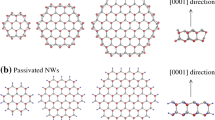Abstract
The electronic structures and work functions of hydrogen (H−), fluorine (F−), and hydroxyl (OH−) passivated silicon nanowires (SiNWs) are evaluated by DFT calculations. We reveal that the work function of SiNW depends strongly on the nature of passivating functional groups, the percentage of passivation and the surface passivated. In particular, a trend of work functions: F-SiNW > H-SiNW > OH-SiNW, is obtained. Taking H-SiNW as the reference, the increased work function in F-SiNW is attributed to the electron withdrawing effect from highly electronegative F atom. In contrast, although O atom is also highly electronegative, for OH-SiNW, such effect is countered by the resonance effect in which electron is donated back to the SiNW surfaces, resulting in reduced work function. The extent of the increment or reduction is proportional to the percentage coverage of the passivating chemicals. Moreover, the work function changes more significantly when the di-substituted (100) surfaces are passivated than that of the mono-substituted (110) surfaces. Consequently, OH-SiNW shows conjugate-liked Si–Si bonds at both the surfaces and the core. The results indicate that the work function of SiNW can be fine tuned by using selected chemical on selected surface with known amount of coverage for customizing purpose.







Similar content being viewed by others
References
Morales AM, Lieber CM (1998) Science 279:208
Holmes JD, Johnston KP, Doty RC, Korgel BA (2000) Science 287:1471
Cui Y, Lauhon LJ, Gudiksen MS, Wang J, Lieber CM (2001) Appl Phys Lett 78:2214
Zhang RQ, Lifshitz Y, Lee ST (2003) Adv Mater 15:635
Wu Y, Cui Y, Huynh L, Barrelet CJ, Bell DC, Lieber CM (2004) Nano Lett 4:433
Read AJ, Needs RJ, Nash KJ, Canham LT, Calcott PDJ, Qteish A (1992) Phys Rev Lett 69:1232
Zhao X, Wei CM, Yang L, Chou MY (2004) Phys Rev Lett 92:236805
Zhang RQ, Lifshitz Y, Ma DDD, Zhao YL, Frauenheim Th, Lee ST, Tong SY (2005) J Chem Phys 123:144703
Ng MF, Zhou LP, Yang SW, Sim LY, Tan VBC, Wu P (2007) Phys Rev B 76:155435
Ng MF, Shen L, Zhou LP, Yang SW, Tan VBC (2008) Nano Lett 8:3662
Svizhenko A, Leu PW, Cho K (2007) Phys Rev B 75:125417
Leu PW, Svizhenko A, Cho K (2008) Phys Rev B 77:235305
Sorokin PB, Avramov PV, Kvashnin AG, Kvashnin DG, Ovchinnikov SG, Fedorov AS (2008) Phys Rev B 77:235417
Leu PW, Shan B, Cho K (2006) Phys Rev B 73:195320
Vo T, Williamson AJ, Galli G (2006) Phys Rev B 74:045116
Cui Y, Wei Q, Park H, Lieber CM (2001) Science 293:1289
Hahm J, Lieber CM (2004) Nano Lett 4:51
Cui Y, Lieber CM (2001) Science 291:851
Tian B, Zheng X, Kempa TJ, Fang Y, Yu N, Yu G, Huang J, Lieber CM (2007) Nature 449:885
Gudiksen MS, Lauhon LJ, Wang J, Smith DC, Lieber CM (2002) Nature 415:617
Sze SM, Ng KK (2006) Physics of semiconductor devices. Wiley & Sons, Inc, London
Ma DDD, Lee CS, Au FCK, Tong SY, Lee ST (2003) Science 299:1874
Perdew JP, Chevary JA, Vosko SH, Jackson KA, Pederson MR, Singh DJ, Fiolhais C (1992) Phys Rev B 46:6671
Kresse G, Furthmüller J (1996) Comput Mat Sci 6:15
Kresse G, Furthmüller J (1996) Phys Rev B 54:11169
Blochl PE (1994) Phys Rev B 50:17953
Ng MF, Teo MK, Lim KH, Zhou L, Sullivan MB, Yang SW (2008) Diam Relat Mater 17:2048
Kokalj A (1999) J Mol Graph Model 17:176
Bimberg D, Blachnik R, Cardona M, Dean PJ, Grave T, Harbeke G, Hübner K, Kaufmann U, Kress W, Madelung O, von Münch W, Rössler U, Schneider J, Schulz M, Skolnick (1982) In: Madelung O (ed) Physics of group IV elements and III-V compounds. Springer, New York
Cheng TC, Shieh J, Huang WJ, Yang MC, Cheng MH, Lin HM, Chang MN (2006) Appl Phys Lett 88:263118
Aradi B, Ramos LE, Deák P, Köhler T, Bechstedt F, Zhang RQ, Frauenheim T (2007) Phys Rev B 76:035305
Ponomareva I, Menon M, Srivastava D, Andriotis AN (2005) Phys Rev Lett 95:265502
Nieskens DLS, Ferré DC, Niemantsverdriet JW (2005) Chem Phys Chem 6:1293
Acknowledgments
The authors acknowledge funding from MOE/AcRF RG 28/07.
Author information
Authors and Affiliations
Corresponding authors
Electronic supplementary material
Below is the link to the electronic supplementary material.
Rights and permissions
About this article
Cite this article
Ng, MF., Sim, L.Y., Da, H. et al. Modulation of the work function of silicon nanowire by chemical surface passivation: a DFT study. Theor Chem Acc 127, 689–695 (2010). https://doi.org/10.1007/s00214-010-0779-6
Received:
Accepted:
Published:
Issue Date:
DOI: https://doi.org/10.1007/s00214-010-0779-6



